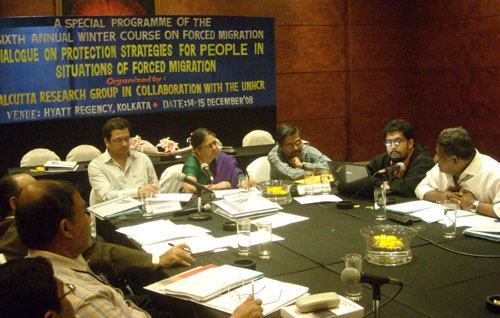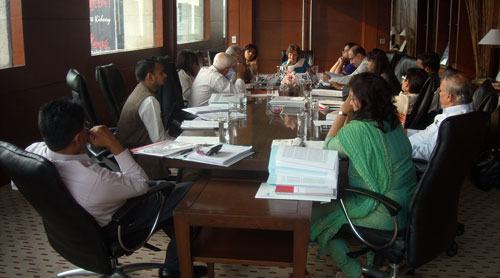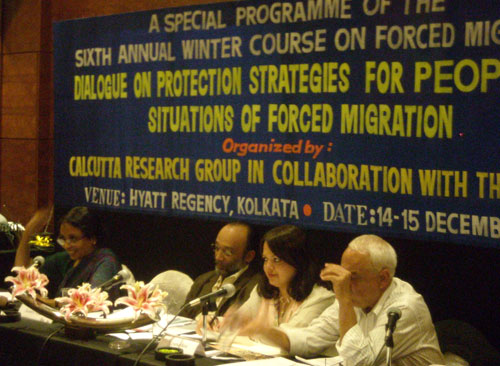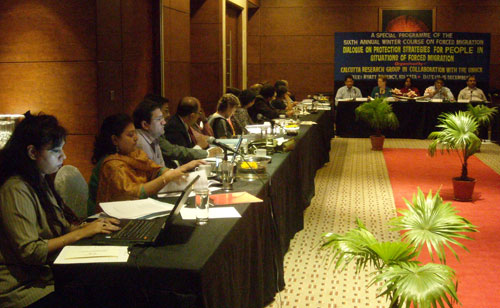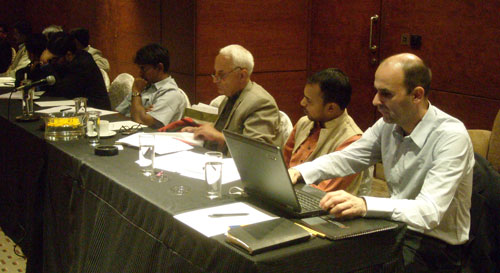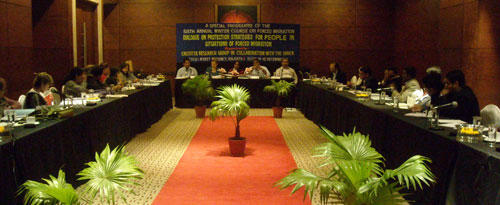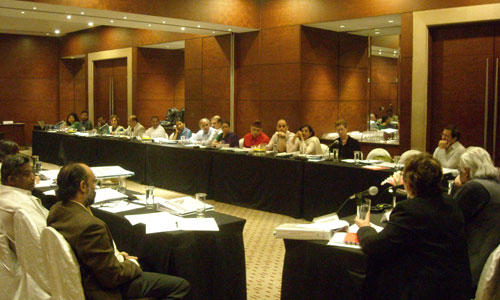The following is the report on the Dialogue on Protection Strategies for People in Situations of Forced Migration. It was organised by the Mahanirban Calcutta Research Group in collaboration with the UNHCR and was held in Kolkata on 14-15 December 2008. In all 42 participants from all over South Asia attended the Conference, besides representatives of the UNHCR from Geneva, Delhi and Kathmandu. Pascale Moreau from UNHCR head office in Geneva and Montserrat Feixes Vihe, the Chief of UNHCR Mission in Delhi participated in the dialogue. The other UNHCR officials included, Nayana Bose and Kiran Kaur from the Delhi office, and Amit Sen from the UNHCR office at Kathmandu. The participants were from various background, some had experience of working in National Human Rights, some have been working in various capacities for protection in UNHCR international offices on migration. Others were experts and academics and noted human rights activists. Some were representatives of organisations of displaced persons. The Conference opened with the release of a book “The Fleeing People of South Asia”, a selection of writings published in the noted South Asian journal Refugee Watch. Madam Montserrat Feixas Vihe released the book. The Valedictory Session was attended by the Governor of West Bengal, where the resolution passed at the Conference was read out. The Governor encouraged the organisers of the Conference to involve the relevant policy makers and appropriate persons in the Government, concerned with the issue of forced migration. This Conference was held as a special part of the Sixth Winter Course on Forced Migration. The Annual Winter Course is supported by UNHCR, the Government of Finland, and the Brookings Institution. Panos South Asia supports the media segment of the Course. Another notable aspect of the programme was the interaction between the visiting UNHCR functionaries and the young participants of the Sixth Winter Course.
I. Background and Main Threads Emerging from the Proceedings
In his opening words, Ranabir Samaddar, Director of the Calcutta Research Group, explained why forced migration occupied a special place in the work of his group, which had convened this dialogue. Forced migration, he recalled, was inextricably linked to the coming into existence of nation-states in South Asia. However, it was also a burning issue of contemporary South Asian realities. The conference, he hoped, would place the South Asian discourse on forced migration in a larger context, provide conceptual clarity and open a window for practical solutions. Dr. Samaddar’s emphasis on the need for innovative approaches to protection strategies is borne out by a sober analysis of facts and figures. At the end of 2007, the total population of conflict-related internally displaced persons (IDPs), according to the Internal Displacement Monitoring Centre, stood at a staggering 26 million, while the number of refugees under UNHCR responsibility, by its own estimate, amounted to 11.4 million. Roughly one third of the global refugee population and 3.1 million IDPs were to be found in the Asia Pacific region alone. The number of refugees in Asia would be significantly higher if one were to include the “partition refugees”, citizens of South Asian countries, residing therein, with an emotional link to a home that was “on the other side” (one participant said: “Unless you have a place you have no displacement”).
The “Ten Point Plan of Action for Refugee Protection and Mixed Migration”, a UNHCR policy paper, lays out a comprehensive system of identifying and addressing protection needs of refugees and other people of concern to the UNHCR. Pascale Moreau stated that durable solutions discussed in the context of refugee protection traditionally include voluntary repatriation, local integration and resettlement in third countries. In the context of globalisation and post-9/11 threat perceptions, however, the consensus on protection regimes, at the core of which lie the 1951 Refugee Convention and 1967 Optional Protocol, has begun to unravel. The principle of non-refoulement has come under intense pressure. Northern countries have been waiving immigration requirements for highly qualified professionals, while simultaneously curtailing the rights of refugees and asylum seekers in favour of institutional guarantees, temporary protection schemes and third country procedures. Countries in the Global South, on the other hand, have voiced their incomprehension as to why they would be expected to abide by standards that the North no longer seemed to be willing to accept even though, in terms of both total numbers and proportion, the latter assumed only a fraction of the global responsibilities for refugees. Meanwhile, it is clear that any strategising for comprehensive protection systems will only be meaningful in the framework of a participatory global dialogue, with substantial input from quarters of the Global South. The invitation to dialogue thus stands out as the central theme of the Ten Point Plan of Action.
Dialogue has not come easy in a world of ideas cut into chunks and pieces befitting ideological convenience. It is surely no coincidence that the Calcutta Research Group decided to organise this conference in close proximity to a workshop on Frantz Fanon (1925-1961), a psychiatrist born in Martinique, a fighter for the independence of Algeria and a stout anti-colonialist. Fanon, in his book “The Wretched of the Earth” (1961), noted that both the “coloniser” and the “colonised” had to change their existence in order to make a new world, also a “new man”. The creation of the “homme neuf”, the new man, with a skin not black and white but sensitive to the notion of justice, still remains the central idea in the task for protecting the rights of the victims, including the uprooted, and providing justice for them.
Many of the views expressed in the conference betrayed a lingering sense that aggression, oppression, domination and structural violence still constitute the cornerstones of the “post-Fanon” world order. In her lecture on “Racism, Immigration and Xenophobia in the World Today”, at the valedictory session, where the UNHCR Chief of Mission in New Delhi, Madam Monserrat Feixas Vihe reported the proceedings and read out the resolutions adopted at the conference, Fanon’s daughter, Mireille Fanon Mendes France, brought into focus the continued state practice of criminalising the movement of people across borders. She described the detention of migrants in the French camp of Sangatte in terms that brought to mind the imagery of Guantanamo. There certainly is a widespread desire in civil societies across the globe to move away from a state-centric discourse focused on controlling migration. In “Territory, Authority, Rights” (2008), Saskia Sassen has highlighted the importance of developing “democracy across borders” and “participatory politics that decentre and sometimes transcend national political life”, including the territorial fixation of the nation-state. And yet, the inaugural speaker of the conference, Rajeev Dhavan, cautioned against prematurely wishing the state away. In the face of a global financial meltdown, he noted, there was a strong possibility of world civil society having their funding dry up and programs designed to meet protection needs significantly pruned. If that turned out to be the case, it was for the states, he said, to step into the fray and provide alternative resources in order to avoid a situation where protection gaps fuelled another cycle of violence and displacement.
Frequent references to the complexities of globalisation provide the grim backdrop to the discussion in the conference. In the context of the current financial meltdown, the conference noted that the fault lines of migration patterns are increasingly becoming blurred. And yet, empirical evidence shows that most refugees take shelter in countries neighbouring their own or, in any event, remain in the region. This finding was important because it showed that the outbreak of armed conflict along ethnic, religious or political lines still remains very much the “prerogative” of the Third World, along with the resultant flight from persecution. It was noted that the concentration of displacement in the Global South brings home the urgency of burden-sharing, an issue which, despite all rhetoric to the contrary, has remained so far unresolved. The blame game between donors and donor countries and refugee hosting countries reminds us of pre-existing thinking patterns not unlike those in circulation in the colonial era, thinking patterns that block the search for overarching just and fair solutions.
The conference also heard some of the speakers touch on the question of how the imposition of the Western model of the state on large swaths of the Global South has triggered refugee flows of unprecedented proportions (partition) and entrenched the distinction between “insider” and “outsider” that is inherent in identity politics, albeit not just in South Asia. Rendering people stateless is an absurdity, but one that citizenship laws seem to have been reconciled to. It was also acknowledged that climate change knew no borders. The challenges of population movement resulting from global warming are unprecedented and cannot be met by the ratification of a treaty or policies devised at a national scale. So there is an increasing realization among practitioners and academics alike that massive and mixed migration flows, common in South Asia, elude existing definitions and protection frameworks. At the same time, it is undeniable that migrants of all strands require effective safeguards against violence, deprivation, exploitation and exclusion—in this context expanded protection mechanisms of UNHCR, ICRC and other inter-governmental organisations. New conceptual ground thus needs to be broken to translate the complex displacement realities of a new era into sound policies. Against that backdrop, the conference has attempted to do a very important thing: embedding local assessment of coping capacities and regional thinking on protection needs in global processes of decision-making.
II. Presentations and Discussion
Inaugural Session
In the inaugural address (“Protecting Refugees—Entitlement or Welfare?”), Rajeev Dhavan focused on four inter-connected issues underpinning the crisis of the refugee protection system today. First, he highlighted the need to understand how the ‘politics of chaos’ worked in today’s world in order to be able to comprehend the phenomenon of displacement in the larger context. Secondly, he stressed the importance of analysing identity clashes for developing sound policies to stem displacement. Thirdly, he advocated a rights-based approach to refugee protection as the displaced should be empowered to make choices of their own rather than turn into recipients of welfare. Fourth, Dhavan made the case that unless the “songs of love” were being sung louder than the “songs of hate” no effective remedy could be found to displacement.
As guest-in-chief, Pascale Moreau (UNHCR) emphasised the importance of achieving durable solutions through dialogue and cooperation in countries, sub-regions, regions and on a global scale. In that context, she drew attention to the “Ten Point Plan of Action” as well as the annual “High Commissioner Dialogue”, which had been focusing on protracted situations this year and was to bring into focus urban refugees in the year to come. UNHCR was determined to continue its work for respect of the extremely essential principle of non-refoulement and due access to protection mechanisms, she said, based on the understanding that prima facie “refugees want to go home”. Referring to mixed migration flows, Moreau pointed out that UNHCR was willing to expand its partnerships, adding that the legitimate concerns of states, such as national security or burden-sharing, had to be brought on board in devising protection strategies.
Session I
Enumerating various categories of displacement in South Asia, Partha Ghosh, Professor, South Asian Studies, School of International Studies, JNU, (“Mapping the Mixed and Massive Human Flows in South Asia”) pointed out that confusion surrounding the terminology of forced migration made it difficult to examine its socio-political impact. He confessed that he was finding it hard to reconcile the traditional paradigm of power-driven international politics with the notion of borderless regions, but expressed hope that people-to-people contacts would eventually overcome the walls being built by states in South Asia.
Uttam Kumar Das, National Programme Officer, International Organization for Migration, Dhaka (“Refugee Protection in South Asia: A Review of the ad hoc Mechanism and Way Forward”) explored possible avenues toward comprehensive protection of the displaced in South Asia. Noting that none of the states in the region had signed and ratified the 1951 Refugee Convention, he cautioned against viewing the international legal regime on refugee protection as a panacea for the problems of South Asia (it was “too narrow”, “euro-centric” and “insensitive to Global South concerns”). Instead, he advocated the adoption of a rights-based national legal framework for the protection of the displaced as well as a regional mechanism for status determination under the auspices of the South Asian Association for Regional Cooperation (SAARC). K.M. Parivelan, Information Officer, UNDP/TNTRC, Chennai, (“Protection Needs, Current Legal Avenues and New Legal Strategies: A South Asian Perspective”) underlined the need for clarifying the notions of ethnicity and (multiple) identity to be able to understand the reasons and consequences of forced migration in South Asia. He echoed the previous speaker’s regret over the absence of a legal framework for the protection of displaced populations, stating that the protection needs of the displaced were not adequately being addressed by a case-by-case approach. In policy terms, Parivelan highlighted the importance of acknowledging and nurturing a culture of hospitality in hosting populations, ensuring protection in regions of origin and establishing refugee camps in a safe distance from the border.
Participants of the session were in agreement that protection needs of the displaced in South Asia had to be identified and acted upon in an integrated and comprehensive, yet region-sensitive fashion. Ad hoc mechanisms were found to be inadequate instruments to address the complex and multi-layered phenomenon of forced migration. One discussant stated that the 1951 Refugee Convention and the 1967 Optional Protocol continued to be relevant in today’s world, arguing that they provided enough room to be interpreted in the light of changing social realities. The other discussant drew attention to the need for understanding the linkages between the marginalisation of sections of society and forced migration. It was important to recall, she said, that movement of people was not at the root of insecurity, but insecurity was very often at the root of migration. The trafficking of women and children as well as sexual violence before, during and after migration was to be taken into account when conceptualising protection mechanisms in the context of forced migration, she said, along with the broader problem of labour trafficking. It was also pointed out that playing number games was little conducive to ascertaining the scope of protection needs for displaced populations. If the number of refugees had indeed come down, one participant ventured, it only suggested that barriers were becoming more difficult to cross. There was also the suggestion that while mapping and categorising the forced migration flows in South Asia was necessary for proper protection strategies, it was felt that we have to take into account the mixed and, at times, massive nature of these flows and therefore the need for flexibility. Particular attention in the context had to be given to women and children in these mixed flows and thus the greater need for flexibility to protect them.
Session II: Working Groups on Displacement Convening in Parallel Sessions
Working Group 1: Developmental Projects, Internal Displacement, and the Need for New Policies and Practices for the Protection of Victims
Samir Kumar Das, Professor of Political Science, Calcutta University (“Development Projects, Internal Displacement and the Need for New Policies and Practices for the Protection of Victims”) presented four case studies for development-induced displacement in India, namely the Bhakra Dam, the Kuduremukh National Park (Karnataka), a steel production site in Orissa and riverbank erosion in Malda district (West Bengal), in part due to rail and road construction cutting across the natural flow of rivers. Under British rule, the Land Acquisition Act 1894 provided that “the land of people may be acquired by the State for a public purpose meaning thereby for the use of the public at large”. In contrast, the National Policy for Rehabilitation and Resettlement, announced by the Indian government in 2007, aims at striking “a balance between the need for land for development activities, and protecting the interests of farmers, landowners, tenants, the landless and those dependent on it.” However, Das demonstrated that what looked good on paper, in its implementation heavily favoured the interests of private investors. As land rights issues remained trapped in the quagmire of political manoeuvring, the costs of development continued to be borne by the vulnerable segments of society. Das argued that the dominant development discourse had to be challenged in order to find out sustainable and socially acceptable solutions. At the same time, he questioned the credentials of some of the groups claiming to represent people affected or threatened by displacement as mechanisms of accountability had yet to be put in place.
|
|
|
Hina Shahid, a human rights activist from Pakistan was to present her paper (“Pakistan: Displacement Puts Thousands at Risk!”) but due to unforeseen circumstances was unable to attend the conference. In her place, Shahid Fiaz, an expert from Asia Foundation Pakistan, explained how processes of urbanisation were effecting displacement and erecting markers of class, adding that the armed forces were major stakeholders in Pakistan’s mega projects. He cited as examples Guadar Port City in Baluchistan, the Liari Expressway (displacing people from a particular community) and Karachi beach. Those projects, rather than helping the communities concerned, were creating communal and ethnic tensions, he said. And yet, whenever project-induced displacement took place, it was vocally justified in the name of the nation. In an obvious reference to James Scott’s criticism of the concept of “high modernism” (“Seeing like a State”, 1998), Fiaz remarked that the sanctioning of Pakistan’s dam projects on the heels of General Ayub Khan’s introduction of five-year development plans spoke volumes of the scant respect that decision-makers had for the concerned people. In conclusion, Fiaz advised that the time had come for the myth of national development to be dismantled and the notion of ‘collective good’, easily manipulated by the government of the day, be replaced by a democratic process of ascertaining the varied and contradictory interests of a plural society, in Pakistan and elsewhere.
During the discussion, a variety of views emerged on the nexus of strong states, failed states and the responsibility to protect. On the one hand, it was argued that the “redefinition” of sovereignty as responsibility actually strengthened the state, while the need was for putting sovereignty to the test of democratic processes. On the other hand, it was held that defining the state in terms of responsibility would go a long way in confronting impunity. One participant took exception with the mainstream discourse on resources, arguing that land was not an economic resource alone but also a symbol of collective identity and people’s collectives should be given primacy over the state’s “imagined collective”. Another remarked that India’s migration policy was focused on establishing control mechanisms for emigration and immigration across borders, neglecting the linkages of labour migration and displacement. As for policy responses, it was proposed that development projects be decided upon in a participatory approach, with the involvement of social scientists also at the planning stage. Reviews should be carried out not only before a project was started but also after it was completed to ensure that benchmarks of social productivity were met, social costs ascertained and adverse effects for the communities avoided. It was pointed out that there was a need for longitudinal studies on victims of displacement. Control mechanisms had to be established to monitor the activities of international real estate developers.
Working Group 2: The Role of the National Human Rights Institutions in Protecting the Victims of Forced Migration
Explaining the proliferation of Human Rights Commissions (HRCs) the world over against the backdrop of a “new culture of governance”, Mario Gomez, International Commission of Jurists, Colombo, Sri Lanka (“National Human Rights Commissions and IDPs: The Sri Lankan Experience”) stated that the protection of IDPs had increasingly been incorporated into the mandate of HRCs. Among the IDP-related activities conducted by HRCs he counted the following: monitoring the access of displaced populations to basic supplies and services; conducting camp visits and field surveys; handling complaints; engaging with the armed forces and militants to minimise consequences for the war-affected population as well as assisting in the drafting of policy and legislation. The Sri Lankan HRC, in his assessment, had capacity and potential but was facing a host of difficulties. It was operating in adverse political conditions (it was, for example, being denied access to “High Security Zones” where displacement routinely occurred), he said, aside from being handicapped by structural deficiencies, including the procedure for appointment of commissioners.
|
|
|
|
Shiva Dhungana, Friends for Peace, Kathmandu, Nepal, (“Policies and Practices of the National Human Rights Commission in Nepal with respect to IDPs”) pointed out that the Nepali HRC had come a long way since its inception in 1997. The HRC had not only become a constitutional body but also increased its presence in the field and its capacity to train staff and cooperate with civil society. On the other hand, the HRC still lacked a holistic approach and program continuity, while having limited reach and little investigative capacity. Dhungana lamented that recommendations were often not implemented (‘no response by the government’), the compensation framework was inadequate, interaction with the media insufficient and data management in infancy. Further obstacles were posed by political interference and undue politicisation of human rights issues. NGOs continued to play a vital role in meeting the protection needs of the displaced, he said, be it with regard to assessing conditions or providing allocation for return or looking into issues of security, livelihood or return of property.
There was consensus among the participants that HRCs, being state institutions set apart from the government in terms of mandate and budget, had an important monitoring role to play (“a good law does not always produce a good result”), but opinions seemed to vary on the exact scope of responsibilities to be assumed by them. Some participants felt that HRCs should focus on building regional and international networks as well as partnerships with NGOs and the media to help advocate the needs of displaced populations in an increasingly hostile political climate . Others expressed the view that if HRCs were to monitor compliance with international humanitarian law, conflict-induced displacement could be cut at the root. Most participants maintained that HRCs suffered not so much from lack of capacity as they did from lack of leadership and political will. In order to improve performance it was suggested that the International Coordinating Committee periodically review HRCs in accordance with the Paris Principles.
Working Group 3: Victims of Violence on the Borders and the Humanitarian Tasks
Recalling the burden of partition, Paula Banerjee, Head of the Department, South and South-East Asian Studies, Calcutta University, (“Humanitarian Aspects of Borders in the East and Northeast”) stated that despite “1001 linkages” security concerns overwhelmed “all other equally legitimate concerns and values” in the way border regimes were enforced and borderlands “managed” in South Asia. Borders, she said, were not just lines drawn on a map but places in which, with routine impunity, girls and women were trafficked and security forces engaged in shelling each other, destroying lives and livelihoods of civilians in the process. The media, rather than playing a constructive role in turning the borderlands into liveable areas, contributed to the threat perception associated with borders in the East and Northeast. Borderlands were portrayed as breeding ground for criminal activities and health hazards ranging from terrorism to drug smuggling and HIV/AIDS. Banerjee predicted that the situation of the borders in South Asia would not improve unless and until the plight of the people living in their vicinity was properly addressed.
|
|
|
|
Anuradha Bhasin Jamwal, Executive Editor, “Kashmir Times”, Jammu & Kashmir, (“Victims of Violence on the Borders and Humanitarian Tasks: The Jammu and Kashmir Case”) argued that borders were not just delineations of territory but also “zones of ambiguity” whose resident population took the brunt of a flawed security discourse focused on national assertiveness. Providing empirical evidence from Jammu and Kashmir, Bhasin showed how cross-border firing, landmines, fencing, interference and repression represented aspects of everyday life in the borderlands. While the nation asserted itself in the defence of symbols and the carrying out of rituals, people were forced to migrate across the international border, the Line of Control or further inland. What was the meaning of security, she asked, if people on the borders continued to be victimised, deprived of their identity and rendered homeless?
The presentations were followed by an exchange of views on the history, concept and meaning of borders in South Asia. The speakers and other discussant emphasised the plight of victims of trafficking in the border area. It was however emphasised that trafficking had little correlation with HIV so marking trafficked women as carriers of HIV was not just wrong but also unfair. There was a debate as to whether living in the border might prove empowering for some women but the speakers concluded that even if some women were able to carve out spaces for themselves it was largely a debilitating experience. This was especially so because women living in the borders lived under a militarised structure that in no way helped them. The speakers criticised the efforts of security forces to adopt borders as these measures were often haphazard with civilians often used in espionage and other counter-terrorist activities creating vigilante groups. In the final analysis, the open border between India and Nepal was cited as an example for the feasibility of creating a borderless region. In light of the complexity of the issues involved, it was proposed by the editor of Himal to hold a separate workshop or conference in collaboration with CRG in the near future with a view to shedding light on the impact of fencing on vulnerable populations residing in the proximity of, or migrating across, borders.
Session III: Roundtable Discussion on Media and Displacement
In the opening presentation, Kanak Mani Dixit, Editor, “Himal South Asian”, Kathmandu, Nepal, stressed the importance of local language media for building an understanding of forced migration issues at the grassroots level. He explained that English language media reached a relatively limited audience in South Asia, e.g. the upper class, the elite and the international donor community. Dixit further expressed concern over the lack of media interest in covering stories of forced migration beyond the way they impacted on the everyday life of the hosting population. Bhutanese refugees constituted the second largest refugee group in South Asia, he maintained, but found “near zero” coverage in the Indian media. To the extent that the media did report on displacement, it hardly ever bothered to assess the adequacy of the government’s response. Following the 2008 breach of the Kosi river embankment and the flooding of several districts in Bihar, the Indian government had inexplicably escaped any blame from the media, despite its utter failure to meet the short and long-term needs of the displaced, he noted.
|
|
|
|
In her presentation Pamela Philipose, Women’s Feature Services, New Delhi, (“Media and Displacement: Erasure, Aggravated Focus, and Identity Building”) judged the media coverage of disaster or conflict-induced displacement as “episodic, fractured and insubstantial”. She juxtaposed the media’s ability to comprehensively cover events in real time with a lack of attention to the story behind the story. Displacement was framed in “entertainment-driven” narratives that would alternatively overexpose or trivialise the plight of affected people, she said. Stories of displacement all too often also served the goal of constructing a “national identity”. Philipose argued that the media was in a position to play a role much more conducive to generating understanding about the root causes of displacement if it were to stop viewing migration through the prism of “national security” and adopt a set of frames focused on “people’s security” instead. With that goal in mind, “circular information” patterns and the ‘immersion of the media in national security politics” had to be exposed, she ventured.
Sanjoy Hazarika, noted Journalist, Centre for North-East Studies & Policy Research, New Delhi, (“The Media and Migration: Hype, Prejudice and Misunderstanding”) expressed his indignation over a trend in the media to raise “the finger of suspicion” at migrant groups without investigating the facts first. Elaborating on the shifting demographic composition of Assam and resultant anxieties, he pointed to a “lack of focus in media reporting” and a tendency to simplify complex social and political realities. Both the traditional and the new media were in a deplorable habit to stereotype and club together distinct groups of people with varying legal entitlements and protection needs (“everybody just is a refugee”). Hazarika proposed the formation of a National Immigration Commission which could perhaps think among others, introducing identity cards “for voting purposes and security”. He stressed, however, that protection strategies needed to come from a “better understanding not just of the law but each other”. The media should reflect on the grievances of the voiceless and marginalizsed and initiate “more interaction” with practitioners, policy-makers and people affected by displacement.
In the ensuing discussion, participants voiced the opinion that the national media all too often turned nationalist on regional themes. Unless it adopted a South Asian perspective, the media in South Asia continued to be trapped in “popular geopolitics” and a cycle of “reductionism”. One participant described how it had become routine for the media to take a line from government officials without insisting that the latter own up to the message they wanted to be conveyed (“don’t quote us but write this”). To eradicate “unprofessionalism in the professional media” prescriptive measures and laws would not help. For the media to come around and take responsibility, a sensitisation campaign in schools and colleges was needed. Other interventions pertained to questions of leadership, professional training, competence and courage (“speak truth to power”), editorial ethics (“if you cannot check it, cut it out”), reporting biases (“the UN gets off rather easily”) as well as balancing the “need to go with the strongest story” with protection concerns of people affected by displacement.
Session IV
Providing case studies from South Asia, in particular Bangladesh, Subir Bhaumik, Correspondent, BBC (Eastern India), (“Resource Crisis, Environmental Disasters, and Climate Change in South Asia: Policy Implications for the Protection of Victims of Forced Migration”) maintained that the manifold manifestations of climate change, such as rising sea levels, melting glaciers, droughts and floods, were translating into a new pattern of conflict over resources, in particular water. To the extent that people affected by climate change chose to resort to the most radical means of adaptation, which was migration, they found borders getting fenced and their grievances dismissed (shrimp cultivation, for instance, flourishes in saline water but needs much fewer people than farming).
Interactive Session of the Conference
Highlighting the diversified needs flowing from various strands of displacement in South Asia, Jeevan Thiagarajah, Executive Director, Consortium of Humanitarian Agencies, Colombo, Sri Lanka, (“Protracted Displacements in South Asia and the Need for Concerted Action”) touched on the concept of human security (as enunciated in Armatya Sen’s writing) and the role of the state, including its reluctance to take concerted, also legislative, action in the face of protracted displacement. What emerged from the paper and the following discussion was the paradox that even where the state had chosen to act, the waters had been muddled to an extent where the root causes of displacement had not created so much of problem as was the cost of protected nature of displacement. Commenting on the massive displacement in Sri Lanka, Thiagarajah referred to the UN Guiding Principles on Internal Displacement as a “useful” complementary tool “to ensure the protection of IDPs”.
|
|
Drawing on the South Asian experience, Bhavani Fonseka, Centre for Policy Research, Sri Lanka (“Do the Displaced Have a Right to Return? A Close Look at South Asian Experiences”) examined the concept of the right to return, in international and domestic law, as one option among others to be made available to refugees and IDPs. Fonseka insisted that national governments, assisted by UN agencies and international NGOs, take the lead in devising and implementing laws and policies designed towards ensuring return, reintegration and rebuilding of lives and livelihoods in safety and dignity. In an important qualifier, she maintained that legislative measures were not going to help resolve situations if they were rushed into and ill-advised.
The presentations invited a host of comments and questions pertaining to climate change-induced displacement, the role of the state in addressing protracted displacement and the right to return. One participant cautioned against the use of language likely to cause misunderstanding, such as the term ‘climate migrant’. Another participant noted that the phenomenon of climate change drove home the point that growth-oriented development was not going to be sustainable. He called for pressure to be brought to bear on governments in South Asia, as also of the North, to change the existing development paradigm. While there was consensus on the importance of finding solutions in accordance with the wishes of the displaced, it was pointed out that it was difficult to know what the displaced wanted. Questions also arose with respect to suitable mechanisms for invoking the right to return, bringing in the element of restitution and implementing the right to return when it clashed with national security concerns. Wrapping up the session, Ranabir Samaddar made the submission that for all the importance rightly attached to the right to return, what should not be forgotten was the “right to stay in two places”.
III. Recommendations
South Asia today is a region combining push and pull factors for migration. Economic growth rates and human development indices stand in stark contrast. The region boasts of ethnic diversity, natural resources and human capital. At the same time, poverty is rampant, armed conflict endures and climate change threatens lives and livelihoods, especially in the “low elevation coastal zones”. South Asia is key to the success of global campaigns designed towards meeting the Millennium Development Goals, mitigating the humanitarian consequences of asymmetrical, including intra-state conflict and reversing conditions leading to global warming. Success or defeat of these campaigns will make a world of a difference for millions of people. Maybe they will stay home. Or maybe they will be on the move. So what can be done? In the concluding session, the participants of the conference agreed on a set of recommendations, which is enclosed in the appendix below. Montserrat Feixes Vihe read out the recommendations during the valedictory session. The recommendation was also noted by Shri Gopal Krishna Gandhi, the Governor of West Bengal. He urged CRG to bring it to the notice of policy makers so that concrete actions could be taken on them. CRG members noted the Governors advice with humility and pledged to make every effort so that the recommendation can reach the policy makers of South Asia as widely as possible.
Kolkata/Delhi, 25 December 2008
Rapporteurs: Patrick Hoenig,Visiting Professor, Academy of Third World
Studies, Jamia Millia Islamia
Aditi Bhaduri, Independent Journalist & Researcher
Oishik Sircar, Human Rights Lawyer & Independent Researcher
